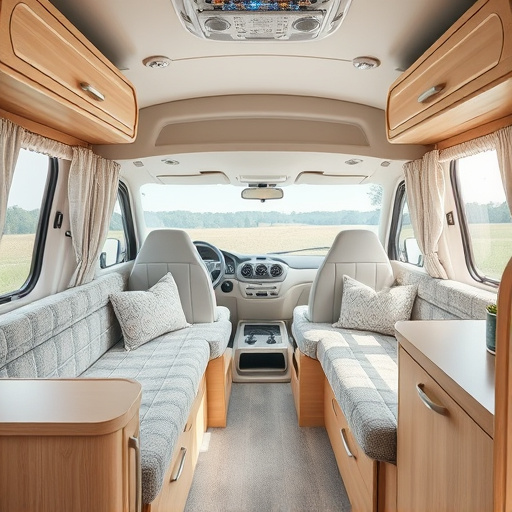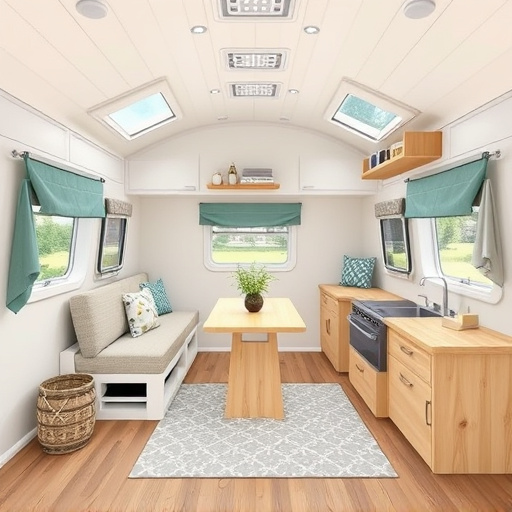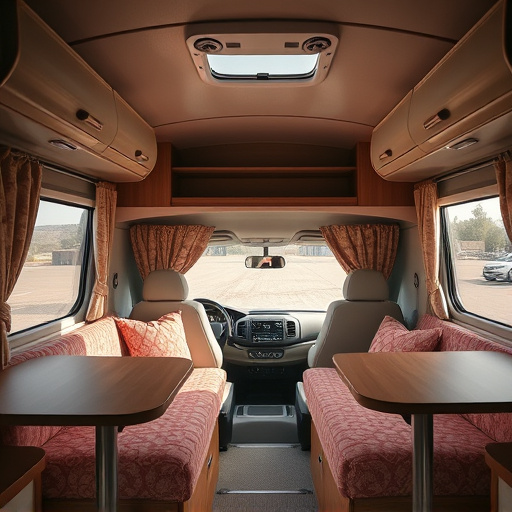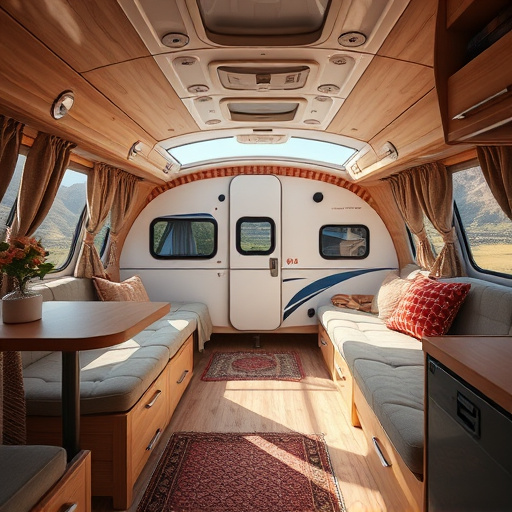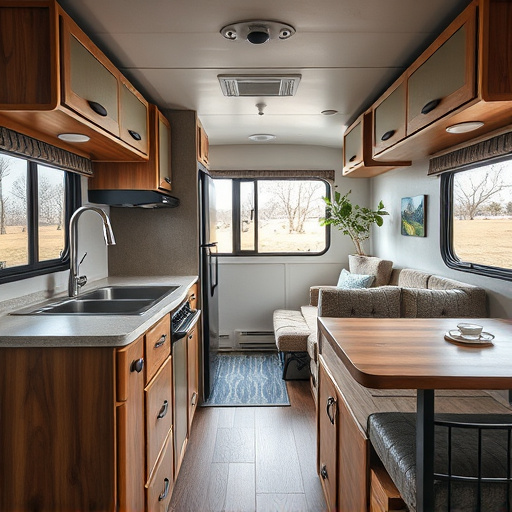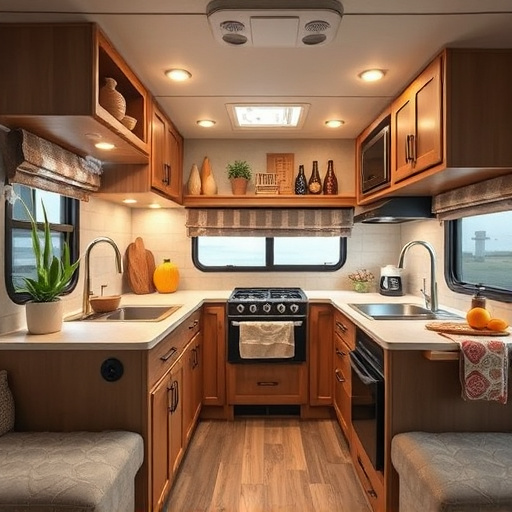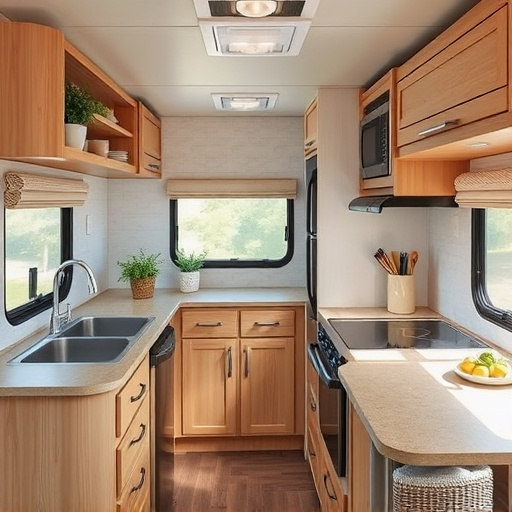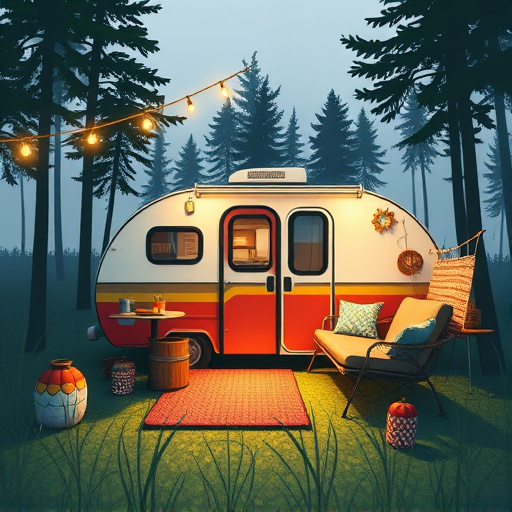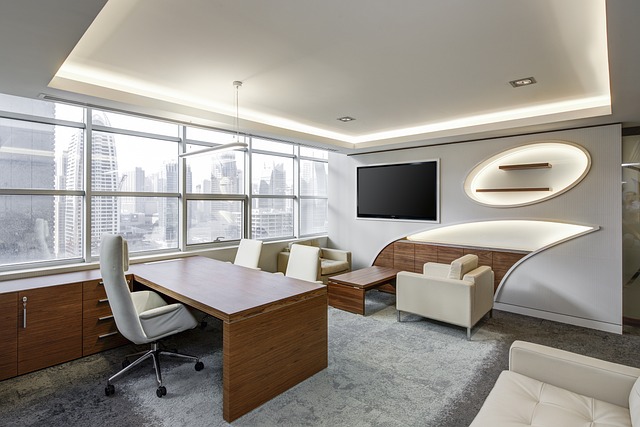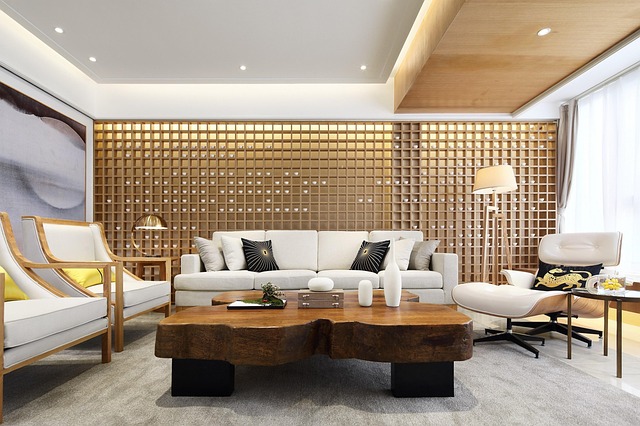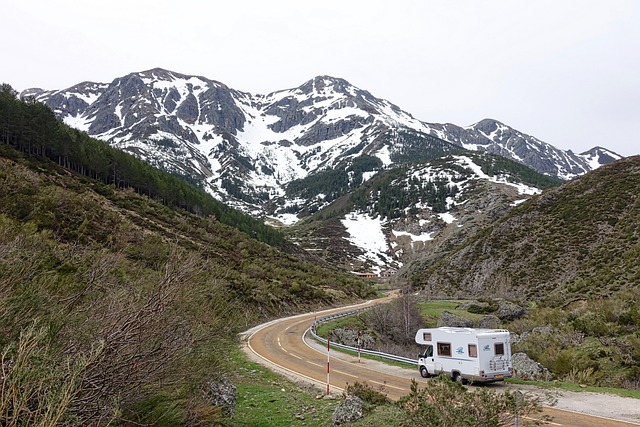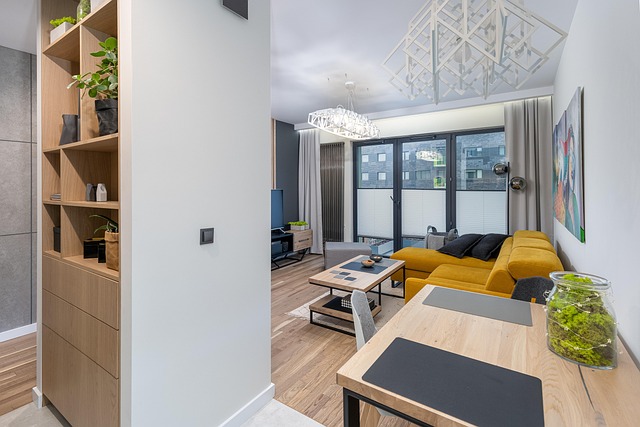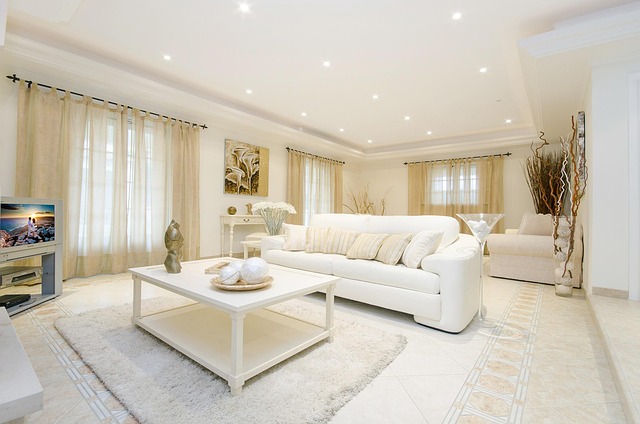Caravan Inside: A Comprehensive Exploration
Introduction
Welcome to an immersive journey into the world of caravan inside—a dynamic and ever-evolving concept that has captured the imagination of many. This article aims to dissect and demystify every facet of caravan inside, offering a comprehensive guide for both seasoned enthusiasts and curious beginners. We will delve into its historical roots, global reach, economic implications, technological innovations, regulatory frameworks, challenges, and future prospects. By the end of this exploration, readers will gain a profound understanding of this multifaceted phenomenon.
Understanding Caravan Inside: Unveiling the Concept
Definition and Core Components
Caravan inside, in its essence, refers to the interior design, functionality, and technology incorporated within recreational vehicles (RVs) commonly known as caravans or trailers. It encompasses the entire living space within these portable structures, transforming them into cozy, fully-equipped homes on wheels. The core components include:
- Living Area: This is the central hub where caravanners relax, socialize, and entertain themselves. It includes seating arrangements, dining areas, and often, a convertible bed system.
- Kitchenette: A compact cooking area equipped with a stove, sink, refrigerator, and storage spaces, allowing for on-the-go meals.
- Bathroom: A functional bathroom facility comprising a shower, toilet, and sometimes a sink, ensuring comfort during journeys.
- Bedrooms: Cozy bedrooms, often with bunk beds or double beds, provide resting spots for travelers.
- Storage: Efficient storage solutions are essential to maximize space and accommodate personal belongings.
- Entertainment Systems: Modern caravans feature flat-screen TVs, sound systems, and gaming consoles for leisure activities.
Historical Context and Evolution
The concept of caravan inside has its roots in ancient civilizations that traveled across vast lands, seeking new horizons and resources. Nomadic tribes used to construct temporary shelters on horses or camels, which served as their homes during migrations. Over centuries, this evolved into the design of mobile homes, with early caravans appearing in Europe during the 18th century. These early models were simple, focusing primarily on transportation rather than interior comfort.
The modern caravan inside began to take shape in the mid-20th century when leisure travel gained popularity. Manufacturers started incorporating more amenities and improving interior designs to cater to the growing demand for comfortable and versatile recreational vehicles. Technological advancements further revolutionized caravans, adding features such as central heating, air conditioning, and larger windows for better visibility.
Global Impact and Trends
International Influence and Regional Variations
Caravan inside has left an indelible mark on the global travel and recreation industry. Its influence is felt across different continents, with each region adopting and adapting the concept to suit local preferences and climates:
- Europe: Known for its rich caravaning culture, Europe offers a wide range of models catering to diverse needs. Countries like Germany and Italy are renowned for their high-quality craftsmanship and innovative designs.
- North America: The United States and Canada have a thriving caravan industry with a focus on spacious interiors and advanced amenities. American caravans often emphasize off-road capabilities and ruggedness.
- Australia and New Zealand: These countries, with vast open spaces and diverse landscapes, have a unique caravan culture. Their models are designed to withstand harsh conditions and feature robust construction.
- Asia: Rapidly growing economies in Asia have led to an increase in the demand for caravans, especially in countries like China and India. Asian caravans often prioritize affordability and practicality.
Key Trends Shaping the Industry
Several global trends are influencing the caravan inside industry:
- Customization: Modern caravanners seek personalized experiences, leading to a rise in customizable options. From choosing interior colors to adding unique features, this trend empowers owners to create their dream caravans.
- Lightweight and Efficient Design: There is a growing demand for lighter, more fuel-efficient caravans, reflecting environmental concerns and the desire for cost savings.
- Integration of Technology: Smart home technology, such as automated lighting, temperature control, and entertainment systems, is increasingly being integrated into caravans, enhancing comfort and convenience.
- Off-Grid Capabilities: With a rise in outdoor adventures, many caravanners seek models with off-grid power and water systems, allowing them to explore remote locations independently.
- Focus on Sustainability: Eco-friendly materials and energy-efficient appliances are gaining popularity as consumers become more conscious of their environmental impact.
Economic Considerations: Market Dynamics and Investments
Market Size and Growth
The global caravan inside market has experienced substantial growth over the past decade, driven by several factors:
- Increased Leisure Time: Changing work patterns and a growing emphasis on work-life balance have led to more leisure time for travel.
- Rising Travel Trends: The COVID-19 pandemic accelerated a trend towards outdoor adventures, with many families opting for caravanning as a safe and enjoyable vacation option.
- Demographic Shifts: Younger generations, accustomed to technology and experiences over material possessions, are embracing caravanning as an affordable and flexible lifestyle choice.
Market Segmentation
The market can be segmented based on various criteria:
| Segment |
Description |
| By Type |
Standard Caravans, Fifth Wheels, Pop-Up Trailers, Toy Haulers, Off-Road Caravans |
| By Size |
Compact (Under 20 ft), Mid-Size (20-30 ft), Large (Over 30 ft) |
| By Price |
Budget (Entry Level), Mid-Range, Luxury (Premium Features) |
| Target Audience |
Families, Individuals, Couples, Retirees, Outdoor Enthusiasts |
Investment Patterns and Trends
Caravan inside is not just a hobby; it’s a significant investment for many. Here are some notable trends:
- Second-Hand Market: Many buyers opt for used caravans, which offer cost savings and a broader range of options. Online platforms have facilitated easy access to second-hand caravans worldwide.
- Customized Conversions: Some individuals invest in converting existing vehicles, such as vans or pickup trucks, into custom caravans, allowing for unique designs tailored to their preferences.
- Real Estate Investment: In certain regions, caravanning has become a form of alternative real estate investment, with the potential for rental income and increased property values.
Technological Advancements: Revolutionizing Caravan Inside
Innovations in Design and Functionality
Technology plays a pivotal role in enhancing the caravan inside experience. Some notable advancements include:
- Smart Home Integration: Voice assistants, automated lighting systems, and temperature control panels allow for hands-free operation and energy efficiency.
- Solar Power Systems: Integrated solar panels with advanced batteries enable off-grid power generation, promoting sustainability and independence while camping.
- Entertainment Upgrades: High-definition TVs, surround sound systems, and interactive gaming consoles provide entertainment options rivaling home theaters.
- Safety Features: Advanced driver assistance systems (ADAS), such as collision avoidance and lane departure warnings, improve road safety for caravanners.
Internet of Things (IoT) and Connectivity
The integration of IoT in caravans has opened new possibilities:
- Remote Monitoring: Sensors can monitor various parameters like water pressure, battery levels, and temperature, allowing owners to manage their caravans remotely.
- Predictive Maintenance: By analyzing data from sensors, manufacturers can predict maintenance needs and schedule service before breakdowns occur.
- Real-Time Navigation: Connected caravans can provide real-time route planning and navigation, ensuring efficient journeys.
Future Potential and Challenges
While technology offers immense potential, challenges exist:
- Data Security and Privacy: As more devices connect to the internet, ensuring data security and privacy becomes critical.
- Compatibility and Standardization: With numerous technological options available, standardization is essential to ensure seamless integration.
- Cost Implications: High-tech features can significantly increase caravan prices, making them less accessible to some buyers.
Policy and Regulation: Navigating the Legal Landscape
Key Policies and Regulatory Frameworks
The caravan inside industry operates within a framework of various policies and regulations designed to ensure safety, environmental protection, and consumer rights:
- Vehicle Safety Standards: Each country has specific regulations for vehicle safety, including crash testing, fire safety, and emission standards.
- Road Traffic Laws: Caravans must adhere to road traffic rules, often requiring special licensing or permits for towing and driving.
- Environmental Regulations: These include emissions control, waste management (especially in remote areas), and sustainable practices in manufacturing.
- Consumer Protection: Policies safeguard consumers’ rights, ensuring product quality, warranty coverage, and fair trading practices.
Impact on Industry Development
Policies and regulations significantly influence the industry:
- Safety and Quality Assurance: Strict standards ensure that caravans are safe, reliable, and of high quality, enhancing consumer confidence.
- Standardization: Regulations can drive standardization, making it easier for manufacturers and owners to navigate the market.
- Market Access: International trade policies impact the import and export of caravans, shaping global market dynamics.
- Innovation and Compliance: Manufacturers must innovate while adhering to regulations, driving technological advancements in compliance with legal requirements.
Challenges and Criticisms: Overcoming Obstacles
Common Issues and Concerns
Despite its growing popularity, caravan inside faces several challenges and criticisms:
- Cost: Caravans can be expensive, especially high-end models with advanced features. This exclusivity may limit accessibility for some buyers.
- Towing Requirements: Driving and towing a caravan requires specific skills and knowledge, posing challenges for novice drivers.
- Maintenance: Regular maintenance is essential to keep caravans in top condition, adding to ownership costs and responsibilities.
- Limited Space: While modern designs maximize space, caravans still offer limited living area compared to traditional homes.
- Environmental Impact: Despite strides in sustainability, caravanning has environmental implications, particularly in remote areas with waste management challenges.
Strategies for Improvement
To address these issues:
- Financial Assistance and Incentives: Governments can offer incentives or subsidies to make caravanning more affordable for first-time buyers.
- Driver Training Programs: Comprehensive training programs can help novice drivers gain the necessary skills, enhancing safety on the roads.
- Maintenance Packages: Manufacturers and dealers could provide extended service plans or maintenance packages to offset ongoing costs.
- Modular Designs: Future designs could incorporate modular concepts, allowing for more flexible and customizable living spaces.
- Waste Management Solutions: Innovative waste management systems and responsible tourism initiatives can minimize the environmental impact in remote areas.
Case Studies: Real-World Applications and Lessons Learned
1. Family Adventure: The Ultimate Road Trip
Scenario: A family of four embarks on a year-long road trip across North America, utilizing a spacious and family-friendly caravan.
Lessons Learned:
- Customization is key to accommodating diverse needs—from separate sleeping areas for kids to ample storage for outdoor gear.
- Energy efficiency becomes crucial during extended stays, prompting the use of solar panels and energy-saving appliances.
- The ability to connect with nature and immerse themselves in local cultures enhanced the family’s bond and created lasting memories.
2. Off-Grid Camping: A Retreat into Wilderness
Case: A group of outdoor enthusiasts invest in an off-grid caravan, venturing into remote wilderness areas for extended camping trips.
Insights:
- Self-sufficiency is paramount; solar panels, water filtration systems, and portable waste management solutions are essential for remote locations.
- The quietness and solitude of nature offer a unique therapeutic experience, away from the hustle and bustle of everyday life.
- This style of caravanning fosters a deeper connection with the environment, encouraging responsible stewardship of natural resources.
3. Urban Caravaning: A Lifestyle in Motion
Background: Young professionals opt for compact, stylish caravans to live and work remotely while exploring urban environments.
Observations:
- Design versatility is crucial; space-saving furniture and multi-functional areas allow for optimal utilization of limited space.
- High-speed internet connectivity and co-working spaces within the caravan enable remote work, attracting a new generation of digital nomads.
- Urban caravanners contribute to a vibrant community, sharing experiences and tips through online forums, fostering a sense of camaraderie.
Future Prospects: Looking Ahead
Emerging Trends and Growth Areas
The caravan inside industry is poised for significant growth and evolution in the coming years:
- Sustainable Caravanning: As environmental concerns grow, eco-friendly materials, energy-efficient appliances, and off-grid capabilities will become standard features.
- Smart Home Automation: Advanced automation systems will transform caravans into fully connected homes, offering remote control and monitoring capabilities.
- Modular Design Revolution: Manufacturers may adopt modular design concepts, allowing owners to customize layouts, add or remove modules, and adapt to changing needs.
- Techno-Tourism: The integration of virtual reality (VR) and augmented reality (AR) could enhance travel experiences, providing digital tours and interactive guides for caravanners.
- Global Caravanning Communities: Online communities will continue to grow, connecting caravanners worldwide, sharing tips, and fostering a sense of global community.
Strategic Considerations
To capitalize on future prospects:
- Manufacturers should focus on sustainable practices and innovative design while adhering to environmental regulations.
- Collaboration between technology companies and caravan manufacturers can drive the development of integrated smart home systems.
- Modular design concepts will offer greater flexibility, catering to diverse consumer preferences.
- Investments in digital platforms and online communities can enhance customer engagement and support global connectivity.
Conclusion: Navigating the Future of Caravan Inside
The concept of caravan inside has evolved from a simple mobile home to a sophisticated, technology-driven lifestyle choice. Its global impact is evident across diverse cultures, with each region adding its unique flavor to this dynamic industry. As technology continues to advance and environmental consciousness grows, the future of caravan inside looks bright, offering exciting possibilities for both manufacturers and enthusiasts.
By embracing innovation, sustainability, and community engagement, the caravan inside industry can cater to a wider range of travelers while preserving the essence of exploration and adventure. This comprehensive exploration provides a roadmap for understanding, appreciating, and participating in this captivating aspect of modern travel.
FAQ Section: Answering Common Queries
Q: How do I choose the right caravan size for my family?
A: Consider your family’s needs, preferred activities, and budget. Larger caravans offer more space but come with increased costs and handling challenges. Compact models are suitable for smaller families or those focusing on off-road adventures.
Q: What safety features should I look for in a caravan?
A: Prioritize stability and tow ratings, ensure proper braking systems, and opt for caravans with fire suppression systems, carbon monoxide detectors, and emergency exit windows for added safety.
Q: Can I convert my van into a caravan?
A: Absolutely! Custom conversions are popular, allowing you to design a caravan tailored to your preferences. However, ensure structural integrity, proper ventilation, and compliance with local regulations.
Q: How do I maintain the interior of my caravan in top condition?
A: Regular cleaning, sealing seals, and addressing water leaks promptly are essential. Store items securely to prevent damage during travel, and consider a thorough winterization routine for colder climates.
Q: Are there any tax benefits for buying a caravan?
A: Tax incentives vary by region. Some countries offer tax exemptions or deductions for purchasing energy-efficient or off-grid caravans, encouraging sustainable caravanning practices.
Vacationer caravans offer a unique blend of mobile living and modern comfort, featuring fully functional kitchens, cozy sleeping areas, and entertainment systems. They are popular among adventurers seeking freedom and convenience, fostering a se…….
Continue Reading
Vacationer Caravans offer an affordable, comfortable way to explore the open road with various models catering to different lifestyles and budgets. Key features include plush mattresses, efficient insulation, spacious interiors, smart lighting,…….
Continue Reading
The modern caravan inside has evolved into a luxurious retreat, offering travelers comfort and style. With thoughtful design, it features plush bedding, well-equipped kitchens, entertainment systems, and spacious living areas that feel like home…….
Continue Reading
Vacationer Caravans are modern, mobile homes designed for contemporary travelers, offering home comforts while exploring new destinations. With diverse models catering to families and couples, these caravans provide versatility, climate control,…….
Continue Reading
Caravan living has seen a surge in popularity, with modern "caravan inside" designs offering comfortable, stylish, and functional accommodations for vacationers. Driven by remote work and unique travel experiences, these caravans appea…….
Continue Reading
Luxury caravan travel has surged in popularity, offering travelers a unique blend of immersive experiences and home-like comfort. Modern caravans are meticulously designed with advanced amenities like spacious interiors, premium bedding, fully e…….
Continue Reading
Caravan travel has gained immense popularity due to trends like remote work and eco-friendly vacations. Vacationer Caravans offer a unique blend of comfort, portability, and nature connectivity, appealing to diverse tastes. With well-designed in…….
Continue Reading
Creating a comfortable caravan inside Vacationer Caravans is key to an enjoyable trip. This involves strategic interior layout with ample space, clever storage, and essential features like comfortable mattresses, supportive bedding, good ventila…….
Continue Reading
The interior design of vacationer caravans prioritizes practicality and comfort for families, maximizing limited space through clever layouts and multifunctional furniture. Equipped with efficient appliances, flexible living areas, and private b…….
Continue Reading
Modern Vacationer Caravans offer a remarkable blend of luxury living and mobile recreation. With stunning aesthetics, meticulously crafted interiors, and high-end finishes, they cater to discerning travelers seeking comfort and style on the move…….
Continue Reading
When choosing a Vacationer Caravan, prioritize personalization for maximum comfort. Opt for high-quality insulation, breathable bedding, and efficient storage to create a cozy interior. Enhance natural light, ventilation, and neutral decor for a…….
Continue Reading
Modern vacationer caravans offer a unique, flexible travel experience with a focus on sustainable design and immersive living. Through strategic natural lighting integration, these vehicles create inviting spaces that reduce energy consumption……..
Continue Reading
Modern vacationer caravans offer luxurious mobile homes blending travel flexibility with home-like amenities, including spacious living areas, fully equipped kitchens, and cozy bedrooms. Designed for comfort and tranquility, these caravans incor…….
Continue Reading
Modern Vacationer Caravans offer a unique blend of luxury travel and mobility, featuring meticulously designed interiors that combine spaciousness with contemporary aesthetics. Equipped with gourmet kitchens, plush sleeping areas, and practical…….
Continue Reading
Vacationer caravans have gained immense popularity due to their unique blend of home comfort and travel freedom, appealing to diverse travelers seeking memorable road trips or off-the-beaten-path adventures. Their design has transformed signific…….
Continue Reading
Vacationer Caravans offer an elevated travel experience with luxurious comfort and modern amenities. Featuring premium sleeping arrangements, high-tech entertainment, and advanced security, these caravans cater to tech-savvy travelers seeking a…….
Continue Reading
Vacationer caravans are a modern trend transforming global exploration, catering to digitally-connected travelers seeking adventure with home comforts. These self-contained, mobile homes offer flexibility, luxury, and immersive experiences witho…….
Continue Reading
Vacationer caravans are versatile, durable vehicles ideal for extended travel, offering spacious interiors with amenities for outdoor adventures. Indoor storage provides protection from weather, wildlife, and vandals, enhancing security and conv…….
Continue Reading
Vacationer Caravans offer diverse bedroom layouts catering to various traveler needs, from compact families to solo adventurers. These designs prioritize comfort and practicality through smart space utilization, featuring bunk beds, pull-out sof…….
Continue Reading
